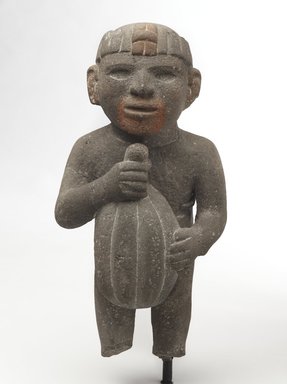Browse

| Accession # | 40.16 |
|---|---|
| Culture | Aztec |
| Title | Man Carrying a Cacao Pod |
| Date | 1440-1521 |
| Medium | Volcanic stone, traces of red pigment |
| Dimensions | 14 1/4 x 7 x 7 1/2in. (36.2 x 17.8 x 19.1cm) |
| Credit Line | Museum Collection Fund |
| Location | American Identities: Colony to Nation / Inventing American Landscape |
| Description | Figure of a man carrying a cacao pod. Left hand holds stem attached to top of pod; right hand rests on middle of pod. Eyes and mouth are open. Traces of red pigment are visible around mouth, ear and central ornament on figure's headdress. Figure wearing traditional loincloth (maxtlatl). Condition: good; right arm is cracked and repaired; feet are broken off; small section of stone on finger near knuckle of right hand is missing; some surface chipping overall. |
Curatorial Remarks: About this Brooklyn Icon
The Brooklyn Museum is commemorating its 200th anniversary by spotlighting 200 standout objects in its encyclopedic collection.
This sculpture of a man carrying a cacao pod exemplifies Mexica stoneworkers’ skill in carving delicate and graceful figures out of coarse volcanic stone. Carved with a compact body and rounded limbs, the man wears the traditional male loincloth (maxtlatl) and headdress. Red pigment, likely derived from the mineral hematite, is visible around his mouth, ears, and central headdress ornament.
Native to the Americas, the cacao tree (Theobroma cacao) thrives in the warm, tropical climates of Mexico and Central America. The ancient Mexica people roasted cacao beans, grinding them into powder before mixing with water and sometimes maize. The resulting drink was seasoned with vanilla, chilies, or other spices. The beverage was so prized that cacao beans were a highly valued long-distance trade item. In addition, the beans were used as tribute and currency in the Mexica Empire. This sculpture may represent one of the long-distance merchants (pochteca) who transported cacao pods from the Gulf Coast to markets throughout the empire.